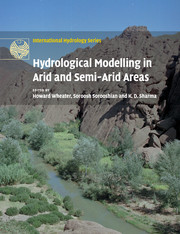Description
Hydrological Modelling in Arid and Semi-Arid Areas
International Hydrology Series
Coordinators: Wheater Howard, Sorooshian Soroosh, Sharma K. D.
A reference on water management in arid and semi-arid regions for researchers and engineers.
Language: English
Subject for Hydrological Modelling in Arid and Semi-Arid Areas:
Hydrological Modelling in Arid and Semi-Arid Areas
Publication date: 03-2018
Support: Print on demand
Publication date: 03-2018
Support: Print on demand
Hydrological modelling in arid and semi-arid areas
Publication date: 11-2007
222 p. · 21.6x27.9 cm · Hardback
Publication date: 11-2007
222 p. · 21.6x27.9 cm · Hardback
Description
/li>Contents
/li>Biography
/li>
Arid and semi-arid regions are defined as areas where water is at its most scarce. The hydrological regime in these areas is extreme and highly variable, and they face great pressures to deliver and manage freshwater resources. However, there is no guidance on the decision support tools that are needed to underpin flood and water resource management in arid areas. UNESCO initiated the Global network for Water and Development Information for arid lands (GWADI), and arranged a workshop of the world's leading experts to discuss these issues. This book presents chapters from contributors to the workshop, and includes case studies from the world's major arid regions to demonstrate model applications, and web links to tutorials and state-of-the-art modelling software. This volume is a valuable reference for researchers and engineers working on the water resources of arid and semi-arid regions.
Preface: Howard Wheater, Soroosh Sorooshian and K. D. Sharma; 1. Modelling hydrological processes in arid and semi-arid areas - an introduction Howard Wheater; 2. Global precipitation estimation from satellite imagery using artificial neural networks Soroosh Sorooshian, K.-L. Hsu, B. Imam and Y. Hong; 3. Modelling semi-arid and arid hydrology and water resources - the southern Africa experience D. A. Hughes; 4. Use of the IHACRES rainfall-runoff model in arid and semi-arid regions B. F. W. Croke and A. J. Jakeman; 5. KINEROS2 and the AGWA modelling framework D. J. Semmens, D. C. Goodrich, C. L. Unkrich, R. E. Smith, D. A. Woolhiser and S. N. Miller; 6. A distributed spatial sediment delivery model for arid regions K. D. Sharma; 7. The Modular Modeling System (MMS): a toolbox for water and environmental resources management G. H. Leavesley, S. L. Markstrom, R. J. Viger and L. E. Hay; 8. Calibration, uncertainty and regional analysis of conceptual rainfall-runoff models Howard Wheater, T. Wagener and N. McIntyre; 9. Real-time flow forecasting P. C. Young; 10. Real-time flood forecasting - Indian experience R. D. Singh; 11. Groundwater modeling in hard-rock terrain in semi-arid areas: experience from India S. Ahmed, J.-C. Maréchal, E. Ledoux and G. de Marsily; Appendix.
Howard Wheater is Head of Environmental and Water Resource Engineering in the Department of Civil and Environmental Engineering at Imperial College London, and co-Chair of UNESCO's Global Network on Water and Development Information for Arid Lands (GWADI).
Soroosh Sorooshian is Distinguished Professor of Civil and Environmental Engineering, and Director of the Centre for Hydrometeorology and Remote Sensing at the Henry Samueli School of Engineering, University of California, Irvine.
K. D. Sharma is Director of the National Institute of Hydrology, India, and a member of UNESCO's Global Network on Water and Development Information for Arid Lands (GWADI) Steering Committee. He is also a visiting fellow at the Chinese Academy of Sciences and the Winand Staring Centre, the Netherlands.
Soroosh Sorooshian is Distinguished Professor of Civil and Environmental Engineering, and Director of the Centre for Hydrometeorology and Remote Sensing at the Henry Samueli School of Engineering, University of California, Irvine.
K. D. Sharma is Director of the National Institute of Hydrology, India, and a member of UNESCO's Global Network on Water and Development Information for Arid Lands (GWADI) Steering Committee. He is also a visiting fellow at the Chinese Academy of Sciences and the Winand Staring Centre, the Netherlands.
© 2024 LAVOISIER S.A.S.




